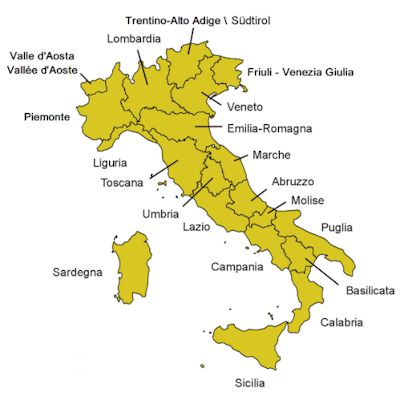
The 15th of all EU-r rights: the right to work and how the Charter contributes
 Gabriel Toggenburg
Gabriel Toggenburg
Like elsewhere the Covid-19 crisis in Italy shows us how critical it is to reflect on what is action and what is reaction in the process of multilevel governing. In this post, I offer reflections on how Italy has been governing its Covid-19 crisis since early 2020. I discuss how and by which instruments, central and subnational authorities have (re)acted and embed my reflections into the broader debate on what has most recently been labelled Italy’s “federal” regionalism.
Basic facts and major issues at stake

Image: Regions of Italy with official names. Author: mac9 (Wikimedia Commons)
Italy is the European country that was first hit by Sars-CoV-2. On 30 January 2020, two Chinese visitors tested positive in Rome. On 18 February 2020, a 38-year-old Italian citizen was hospitalised in the little town of Codogno, Lombardy.
Within a short time, the Covid-19 health emergency involved the whole region of Lombardy (that then became the epicentre), and the north of Italy. Slightly later, the centre and the south of Italy registered an increase in Covid-19 cases, even if to a much lesser extent and with very different numbers from one region to another.
Short-term emergency measures have become an essential component of governing processes and centralisation of power by means of decree laws, the most used governing technique. As has been happening in other regions, a double power shift affecting both the horizontal (from parliament to government) and vertical governmental level (from the subnational to the central authorities) characterised the emergency phase from January to May and led to the adoption of a package of measures that heavily impacted everyday life.
In comparison with other EU members states, Democracy Reporting International (DRI) classified Italy’s measures regarding human rights restrictions as severe (next to France, Hungary and Spain). On the scale comprising ‘moderate, significant, high and severe’, severe in the DRI categorisation means that the measures have had an overwhelming impact on everyday life with personal movement banned/needing authorisation, borders fully closed, no assemblies, schools closed and all but essential businesses shut down.
Chronologically, in Italy, on 11/03/2020 the closure of all commercial and retail businesses was ordered, followed by the closure of all non-essential businesses and industries on 22/03/2020. As educational and cultural institutions, public events and sport manifestations had already been suspended nationwide, both the public and commercial life came to a total halt. The general shutdown was extended twice until 03/05/2020.
At the time of writing, 24 May 2020, the total number of cases reported by the authorities had almost reached 230,000 and Italy, compared to other countries has the sixth highest number of coronavirus cases after the United States, Brazil, Russia, Spain, and the United Kingdom.
Italy’s regions – 20 in total, but 21 in terms of actors responsible for health policy (with the special region Trentino-South Tyrol divided into two autonomous provinces that equal a region regarding the powers they separately hold under the same basic law) – were and still are very differently affected by Covid-19. While all of them have been affected equally by the package of lockdown measures, many of them in phase two, the easing of the lockdown from 4 May onwards, have started to call for their political autonomy in deciding when and how to do it – with the Government prohibiting asymmetric major easing measures before 18 May.
Constitutional void and the action from above
The Italian Constitution (ItConst) lacks clarity when it comes to handling extraordinary situations. The only procedural ‘power-relation scenario’ it provides, is the one in the case of a state of war: In such circumstances, art. 78 of the ItConst, prior to the authorisation of the Parliament, enables the Government to suspend fundamental rights and freedoms by means of a governmental decree having the same force of a law (in Italy, restrictions of fundamental rights and freedoms cannot be regulated by sources other than laws and acts having the force of a law).
In the case of the Covid-19 emergency phase, the Government resorted to the possibility of ruling by decrees. Art. 77 of the ItConst provides for decree-ruling “in case of necessity and urgency”, specifying that law decrees are valid no longer than two months unless they are adopted as formal laws by the Parliament in the meantime.
The Government basically seized all power from regions based on the declaration of a public health state of emergency on 31/01/2020 (with a time limit of six months). This declaration is based on a statutory, not a constitutional, provision: the Civil Protection Act 2018. This Act has empowered the Government to adopt “any necessary measure” within the limits of the “general principles of the legal system and the European Union rules”. However, this Act does not explicitly empower the Government to limit fundamental rights and freedoms. Therefore, on 23/02/2020 decree law no. 6 was issued (converted into law on 05/03/2020). The decree law granted the competent authorities the power to order “any appropriate restrictive measure”. This, initially on 08/03/2020, resulted in a severe lockdown only for the most affected areas in the north of Italy (ordered by a “Decree of the President of the Council of Ministers”, the DPCM), which, after two days the severe lockdown was extended to the entire State territory (again by a DPCM; DPCMs are administrative in nature).
At national level, a long list of measures has been enacted regarding the rules of the lockdown and its gradual easing, comprising decree laws, DPCMs as well as administrative acts from single ministries. The rollout of restrictive measures at national, regional and local level (hundreds of measures!) have made and still make a clear understanding between the measures taken at different governmental levels and their effects very difficult, not least because of the lack of coordination among all players involved.
The national measures have, in one way or another, provided for consultative mechanisms between the regional and central authorities, while underlining that any top-down governing measures would always be legitimised by the fact that they are enacted after hearing an expert task force (established on 05/02/2020). The composition of the expert task force has been supplemented several times by additional experts, and it ultimately has also been updated with regard to gender representation (initially, its composition was male only!). One of its members has also been designated by the president of the intergovernmental body Standing Conference of State-Regions-Autonomous Provinces. However, all in all, consultations with the regions have been rather limited, mainly because of the deficiencies in Italy’s system of intergovernmental relations.
The complex conundrum of intergovernmental relations has been endlessly discussed, but not yet resolved at political level. So, the issue of regional participation to the definition of the State’s political agenda has never been thoroughly addressed. No answer has yet been provided to the possibility of establishing a Senate that represents all territorial autonomies and ends “perfect bicameralism” whereby the Senate and the Chamber of Deputies enjoy exactly the same powers and functions.
The issue of the State-regions relations has, instead, been approached by using the instrument of Conferences (Standing Conference of State-Regions-Autonomous Provinces; State-Local Government Conference; and a unified Conference representing all constituent units). The said joint bodies are regulated by ordinary legislation only and are composed of representatives of the respective governmental executive power. The Conference model, in practice, led to a system of intergovernmental relations, in which bilateralism as a negotiating principle is favoured over multilateralism (both vertically in relation to the State and horizontally in relation to finding political allies for interests across regions) and in which cooperative regionalism, grounded on the principle of loyal cooperation as developed by the Constitutional Court, shall be the working rationale. It has also to be noted, that the five special regions do enjoy additional channels of negotiations next to the Standing Conference (joint commissions between the State and the respective region) and that they, unlike the fifteen ordinary regions, have exclusive legislative and regulatory competence over the system of local government.
The governmental/regional tug of war and the reactions from below
From 4 May 2020, the severe lockdown measures are gradually being eased (travel bans between regions might be removed in early June). Already from mid-April, however, the tug of war between regions and the centre, over the details as to the easing measures has started. Veneto’s lifting of some restrictions ahead of time not only exemplifies how divided Italy is over the question on how to exit the crisis, but also how helpless the Government is in the attempt to collaboratively elaborate relaxing measures that reflect territorial needs. Such needs, on the one side, are very different as Covid-19 continues to affect the regions in an uneven manner, and, on the other, they have to be balanced against the different capacities of the health care systems.
Italy’s National Health Service is regionally based and organised with central authorities controlling the distribution of tax revenue for publicly financed health care and defining the “essential levels of care” to be guaranteed as a benefit package throughout the entire Italian territory. In other words, the 19 regions and two autonomous provinces enjoy significant autonomy in determining the macro-structure of their health care systems and in delivering public health and social care services.
Against this backdrop, Italy’s regions, especially those governed by centre-right, are eager to put their own spin on the rules as to the exact timetable of easing measures (e.g. regarding the opening of bars and restaurants, the access to and allowed activities on beaches, the rules for open sea or open water activities).
Next to Veneto, Calabria serves as another example in this regard: Its governor on 29 April 2020, signed a regional ordinance easing the lockdown, comprising, among others, the permission to reopen bars, restaurants and pizzerias with outdoor table service. On 9 May, the administrative tribunal of Calabria upheld the appeal of the Council of Ministers against the order of the governor of the region and the relevant parts of the regional ordinance were annulled. According to the ruling, it is (to be) up to the central authorities to identify the measures to limit the spread of the coronavirus and the regions are only entitled to intervene within the limits outlined in the national measures.
Overall, regional and local governments since early 2020 have been and are only allowed to come up with stricter restrictions than those issued by the central authorities. The Government positioned itself as the master of the crisis and never missed any opportunity to underline what is “permitted” and what is not, in the interest of safeguarding health as a fundamental right of the individual and as a collective interest (art. 32 of the ItConst).
The special path of the province of Bolzano/Bozen (South Tyrol) is also noteworthy as it is Italy’s only constituent unit that has so far issued the earlier relaxation of the lockdown by means of a provincial law (no. 4 of 8 May 2020), and not an order by a governor. Next to effectively easing the lockdown, already from 8 May onwards (and not from 18 May), the provincial authorities also intended to clearly point to the political autonomy South Tyrol is vested with. Even if South Tyrol’s longstanding governing party, the South Tyrolean Peoples’ Party (SVP), generally is in good relations with the central authorities, Rome could not but appeal to those parts of the law that refer to the field of safety at work, a field for which central authorities are competent and for which they, at the time of the adoption of the provincial law, had not yet advanced the new set of rules. In addition, the case of South Tyrol is of interest because of its geographical position bordering Austria and Switzerland and the ongoing discussions as to fully re-open the Brenner/o pass as one of the most frequented north-south axes in Europe.
Lessons (to be) learned
For the umpteenth time, the Italian responses to Covid-19 in early 2020 point to the deficiencies of its system of intergovernmental relations. Like a magnifying glass, Covid-19 has brought all its inconsistencies to light. The question as to Italy’s federalization and, more concretely, as to its major federal trait, the current distribution of competences, is again discussed.
Back in 2001, constitutional law no. 3 turned the distribution of competences upside down: Legislative exclusive competences of the State as well as subject-matters of concurrent legislation are now listed in the ItConst in art. 117 and regions hold residual powers (with, as said, significant powers in the fields of health care and social services). Mismanagement linked to Covid-19 containment measures has started a discussion at political level over the question whether the competence over health care should again be recentralised.
However, if one considers the bigger picture, the real problem to be addressed is the lack of coordination of concurrent and decentralised competences, not decentralisation per se. The Italian case shows that the public health care system works well in some regions and in others it does not (even though public spending is by and large the same). In early 2020, the regional health authorities were forced to implement regional pandemic plans to the best of their knowledge. Unfortunately, they were outdated, as the national one also was. Consequently, the different territorial systems were badly interconnected and coordinated as to their preparedness and containment operations. This, to varying degrees, compromised the effectiveness of the responses to Covid-19, not decentralisation per se. Before throwing out the baby with the bathtub, one should thus, at last, address a systematic review of the instruments promoting greater correlation and participation between the different institutional levels. As most recently argued, there is and must be space for federalism also in times of emergency, in Italy and elsewhere.
The article was first published here: https://uacesterrpol.wordpress.com/2020/05/29/action-and-reaction-what-covid-19-can-teach-us-about-italian-regionalism/
 |
Elisabeth Alber is a senior researcher at the Institute for Comparative Federalism of Eurac Research. She holds a PhD in Comparative Politics (University of Innsbruck) and studies law and politics in federal and regional States, participatory democracy, territorial autonomies, minority rights and much more. Globetrotting is her passion, and receiving postcards that she meticulously collects does put a special smile on her face. |
This content is licensed under a Creative Commons Attribution 4.0 International license.

 Gabriel Toggenburg
Gabriel Toggenburg
 Nicolò Alessi
Nicolò Alessi
 Lidia Bonifati - Lo Spiegone
Lidia Bonifati - Lo Spiegone